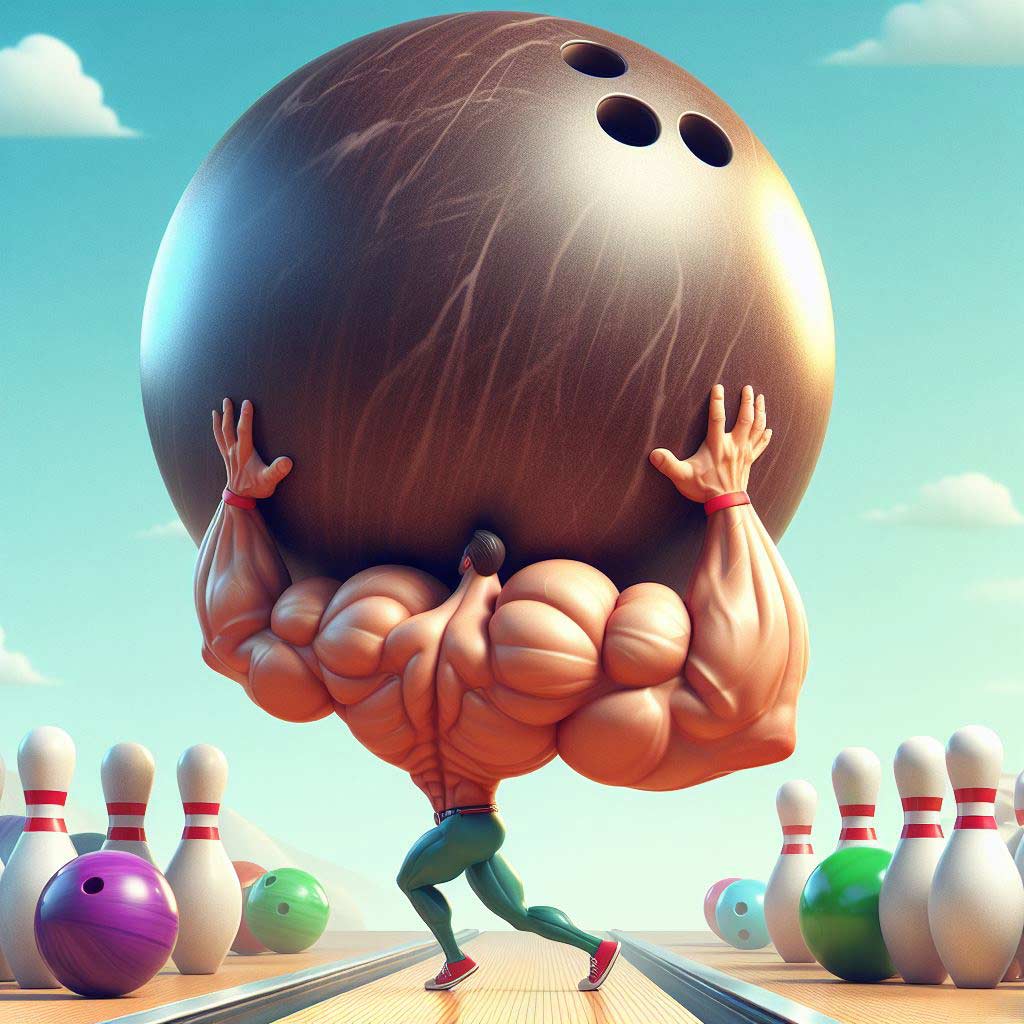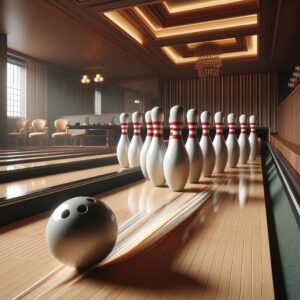When watching professional bowlers effortlessly throw strike after strike, it’s hard not to notice the hefty bowling balls they can wield with such grace and power.
Whether it’s a tournament on television or if you’ve been fortunate enough to catch the pros competing live, you’ll see them smoothly gliding balls weighing anywhere from 14 to 16 pounds down the lane at blazing fast speeds.
As a casual bowler, you may be wondering—just how are they able to control such heavy balls so precisely? What factors go into a pro’s choice of ball weight? And what can an amateur bowler learn from the pros about selecting the right ball weight?
In this in-depth guide, we’ll break down the typical ball weights used by professional bowlers on the PBA and PWBA tours. You’ll learn what goes into a pro’s decision-making process for choosing the optimal ball weight for their game.
We’ll also provide tips and recommendations for how casual and amateur bowlers can find the right weight to maximize their accuracy, power, and consistency on the lanes.
Typical Bowling Ball Weights Used by Professionals
Male professional bowlers on the PBA Tour tend to use heavier bowling balls, ranging from 14 to 16 pounds in weight. The average weight for male bowlers is around 15 pounds.
For women professional bowlers on the PWBA tour, the common weight range is between 10 to 14 pounds. The average pro female bowler uses a ball weighing approximately 12 to 13 pounds.
In general, using a heavier ball weight allows professional bowlers to generate more momentum and hitting power to knock down pins. However, heavier balls can be more difficult to control accurately. So top pros need muscle strength and technical skill to manage the heavier loads.
On the other hand, lighter bowling balls don’t hit the pins with as much sheer force. But lighter weights provide greater control and finesse for pros making more tricky spare shots and precision shots at specific target areas.
Factors That Influence a Professional’s Bowling Ball Weight Selection
Professional bowlers take many factors into account when selecting the optimal ball weight for their game:
- Strength and Comfort Level – Pro bowlers have trained extensively to build up the arm, wrist, and finger strength necessary to wield heavier balls. A weight needs to feel comfortable based on their fitness level.
- Oil Patterns – Heavier balls are more suitable for oily lane conditions because they are less impacted by the oil. Slick lanes allow the momentum of bigger balls to plow through.
- Bowling Style – “Cranker” pros who generate high ball revs at release may opt for heavier weights to maximize pin action. Slower, controlled styles may use lighter balls.
- Equipment Technology – Advanced ball materials and weight block designs allow for new options in weights.
- Personal Preference – Many pros stick with a familiar weight they’ve used for years that just “feels right” for their game.
- Weather Conditions – Colder weather can make gripping a heavy ball more difficult, leading some pros to drop a pound or two.
As elite athletes, pro bowlers have very in-tune senses of feel, balance, and control. So they often know right away if a specific ball weight isn’t right for their strengths, comfort, and bowling style.
This intuitive sense of the optimal weight developed over thousands of games is what allows them to consistently excel.
Breakdown of Ball Weights Used by Famous Professional Bowlers
To give you a better idea of real weights that top professionals use, here is a rundown of some famous pro bowlers and the ball weights they have achieved success with:
- Jason Belmonte – 16 pounds: The Australian star nicknamed “The Bowling Master” is one of the most dominant PBA players of all time. He throws a 16-pound ball to generate big power.
- Liz Johnson – 14 pounds: Among the top women bowlers ever, Johnson was the first woman to make a PBA televised final. She uses a 14-pound ball to match her strength and smaller hand size.
- Norm Duke – 15 pounds: This PBA Hall of Famer is one of only five bowlers with over 40 PBA titles. Duke wields a trusty 15-pound ball for his controlled power game.
- EJ Tackett – 16 pounds: As a tall and strong pro, Tackett can harness a 16-pounder effectively. He focuses on speed and revs over finesse.
- Ronnie Russell – 14 pounds: Using a lighter 14-pound ball, this PBA veteran star has amassed over $1.5 million in career winnings. The lighter weight suits his accuracy.
- Kelly Kulick – 14 pounds: As the first woman to win a PBA tournament, Kulick has an elite arsenal based around a 14-pound bowling ball. This gives her both control and hitting power.
The weights used by the top male and female professionals range widely based on individual factors. But the typical pro uses either 14, 15, or 16 pounds to obtain the optimal blend of control, hitting power, and leverage based on their build and bowling style.
Recommendations for Selecting Ball Weight As a Casual Bowler
For amateur and league bowlers hoping to pick up tips from the professionals, here are some recommendations for finding the right bowling ball weight for your game:
- Test out a range of different weights at your local pro shop to identify what feels most comfortable and natural in your hand. Heavier balls may feel unwieldy at first and require strength training to manage.
- Consider the typical oil patterns on the lanes where you bowl most often. More heavily oiled lanes may allow you to go slightly heavier to cut through the oil better.
- Lighter weight balls around 10-12 pounds are easier to control for beginners and younger children first learning. But don’t go too light or you’ll lack hitting power.
- Work on strength training focused on your fingers, hands, wrists, and forearms to build muscle. This will help you handle incrementally heavier bowling balls with better leverage.
- Opt for heavier balls on full roller sets designed to give you more pin action. Lighter weights are okay for spares and straight shots.
- Remember that optimal weight is a balance between power and control. Sacrificing too much of one quality for the other will hurt your consistency.
While the professionals handle weights from 14-16 pounds, most amateur bowlers will find the sweet spot for control and impact in the 10-15 pound range.
Don’t get frustrated trying to immediately match the pros. Find a challenging but manageable weight to support your ongoing skill development.
With practice using quality bowling balls drilled to fit your hand, you’ll build confidence and strength to move up in weight classes over time. Pay attention to how subtle weight differences impact your mechanics, accuracy, and pin action to make smart decisions.
The Takeaway – Correct Ball Weight Matters for Consistency
Elite professional bowlers have unique skills from thousands of hours of mastering the intricacies of rolling the perfect strike ball. But casual league bowlers can learn a lot from their example about the importance of using an appropriate ball weight.
While heaviness contributes power, it’s not always optimal for amateurs without seasoned strength and technique. And extremely light balls sacrifice valuable momentum and hitting power. The right balance must be struck based on your current skill level.
Testing an assortment of different ball weight options is the best way for all bowlers to find their ideal fit for both control and knockout potential.
Focus on a challenging weight range that supports your ongoing improvement. As your talents progress, reassess periodically to determine if moving up a pound or two could benefit your consistency.
Above all—make sure the weight feels comfortable and natural in your swing. A smooth, free-flowing technique is vital for accuracy. With the right ball weight matched to your abilities, you’ll be knocking down pins like the pros in no time!
Frequently Asked Questions
How many pounds do professional bowlers use?
Professional male bowlers typically use between 14-16 pound bowling balls, while professional female bowlers often use 10-14 pound balls. The average pro uses around a 15-pound ball for men and 12-13 pounds for women.
Is it better to bowl with a heavier ball?
Heavier bowling balls around 14-16 pounds allow pros to generate more power and momentum to knock down more pins. But for amateur bowlers, an overly heavy ball can reduce control and accuracy. Finding the right balance of weight for your strength and skill level is key.
What weight bowling ball do most men use?
The average man uses a bowling ball between 12-16 pounds. Many recreational male bowlers start with 12-14 pounds and work up to 15 pounds as their strength increases. Professional men average 15 pounds.
How do you know if your bowling ball is too heavy?
Signs a bowling ball may be too heavy include struggling to swing straight, needing two hands at release, wrist or finger pain during release, and lack of control targeting specific pins. Dropping weight may improve comfort and accuracy.
How heavy are Jason Belmonte’s balls?
As one of the PBA’s top stars, Jason Belmonte uses maximum weight by throwing a 16-pound bowling ball to generate enormous power and momentum in his dynamic style.
Do pro bowlers pay for balls?
Pro bowlers are usually sponsored by bowling ball brands, so they do not pay for the bowling balls they use in competition. Ball companies provide equipment to pros as part of endorsement deals.
Is it better to throw a bowling ball fast or slow?
Faster bowling ball speeds generally create more power and impact. But accuracy is also critical, so finding an optimal speed that balances control and power for your game is best. Pros use finesse and power shots as needed.
How many pounds should my bowling ball be?
Choosing a bowling ball weight depends on factors like age, strength, skill level, and bowling style. Most amateur men use 12-16 pounds. Women and youth tend to use 10-14 pounds. Try various weights to find the optimal balance of control and power.
Is it easier to bowl with a lighter ball?
Yes, lighter bowling balls around 10-12 pounds are often easier for beginners to control due to requiring less strength and stabilization. But sacrificing too much weight makes achieving power and high scores more difficult.





